ASM Metals HandBook Vol. 8 - Mechanical Testing and Evaluation
Подождите немного. Документ загружается.

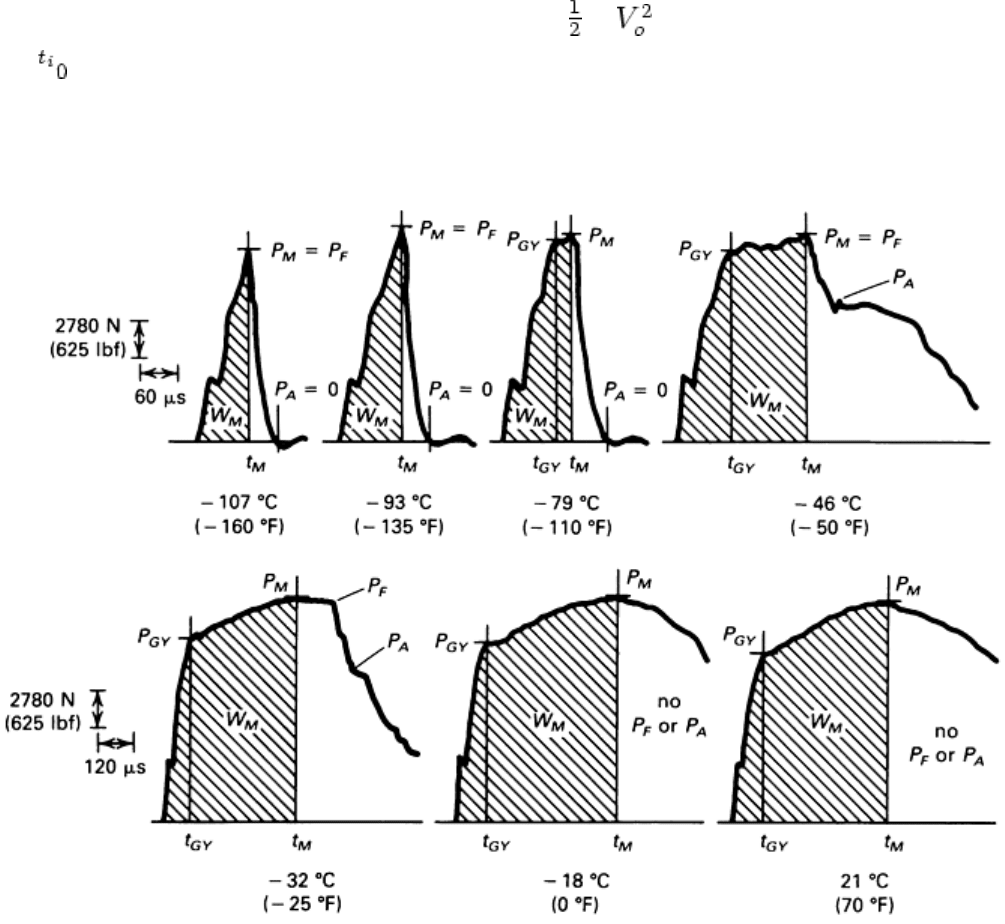
where E
o
is the total available kinetic energy of the pendulum ( m · ) and:
E
a
= V
o
P · dt
(Eq 2)
where V
o
is the initial impact velocity, and m is the effective mass of the pendulum. The ability to separate the
total absorbed energy into components greatly augments the information gained by instrumentation. Load-
temperature diagrams can be constructed to illustrate the various fracture process stages indicative of the
fracture mode transition from brittle to ductile behavior (Ref 26).
Fig. 11 Load-time response for a medium-strength steel. P
M
, maximum load; P
GY
, general yield load; P
F
,
fast fracture load (generally cleavage); P
A
, arrest load after fast fracture propagation; t
M
, time to
maximum load; t
GY
, time to general yield; W
M
, energy absorbed up to maximum load
One of the primary reasons for the development of the instrumented Charpy test was to apply existing notch
bend theories (slow bend) to the dynamic three-point bend Charpy impact test. Obtaining load information
during the standard Charpy V-notch impact test establishes a relationship between metallurgical fracture
parameters and the transition temperature approach for assessing fracture behavior (Ref 27). Initial studies
concentrated on the full range of mechanical behavior from fully elastic in the lower Charpy shelf region to
elastic-plastic in the transition region to fully plastic in the upper shelf region (see Fig. 11).
Most studies have been performed on structural steels, with primary emphasis on the effect of composition,
strain rate, and radiation on the notch bend properties. Interest in instrumented impact testing has expanded to
include testing of different types of specimens (e.g., precracked, large bend), variations in test techniques (e.g.,
low blow, full-size components), and testing of many different materials (e.g., plastics, composites, aerospace
materials, ceramics). The many variations in test methods is a motivation for standardized test methods,
although standardization for instrumented Charpy testing has been slow (see the section “Standards and
Requirements” in this article).
Instrumentation

Instrumentation for a typical Charpy impact testing system includes an instrumented striker, a dynamic
transducer amplifier, a signal-recording and display system, and a velocity-measuring device. The instrumented
striker is the dynamic load cell, which is securely attached to the falling weight assembly. The striker has
cemented strain gages to sense the compression loading of the tup while it is in contact with the test specimen.
The dynamic transducer amplifier provides direct-current power to the strain gages and typically amplifies the
strain gage output after passing through a selectable upper-frequency cutoff.
The impact signal is recorded and stored either on a storage oscilloscope or through the use of a transient signal
recorder. Digital data from a transient recorder can be reconverted back to analog form and plotted on an x-y
recorder, or the digital data can be transferred to a computer for direct analysis.
Triggering is best accomplished through an internal trigger that has the ability to capture the signal preceding
the trigger; external triggering from the velocity-sensing device is often used instead of an appropriate internal
trigger. The velocity-measuring system should be a noncontacting, optical system that clocks a flag on the
impacting mass immediately before impact so that initial velocity measurements can be made. Velocities must
be determined for all impact drop heights used.
The impact machine and the instrumentation package must be calibrated to ensure reliable data. Calibration of
the Charpy pendulum impact machine is performed in accordance with ASTM E 23, as discussed previously in
this article in terms of periodic proof testing of AMMRC calibration specimens to ensure reliable dial energy
values.
Instrumentation calibration consists of a time base and load-cell calibration with a system frequency response
measurement. The time base calibration consists of passing a known time mark pulse through the system and
calibrating accordingly. The load-cell calibration is typically accomplished by testing notched specimens of
6061-T651 aluminum that are only slightly loading-rate sensitive over the range used (Ref 28). The load cell is
calibrated when the measured dynamic limit load is only slightly higher than the predetermined quasi-static
limit load (measured using the same loading arrangement and anvil dimensions) and when the dial energy (or
velocity-determined energy measurement) matches the integrated total energy. The relationship used for
obtaining total absorbed energy, ΔE
o
, from the area under the load-time record follows the approach in Eq 1
and 2.
The calculated ΔE
o
value will match the dial energy reading when the system is calibrated (in addition to the
limit load check). Because the aluminum limit load is fairly low (around 7.1 kN, or 1600 lbf), a check on load-
cell linearity at higher loads is also needed. To accomplish this, the integrated energy/dial energy requirement
for a quenched and tempered 4340 specimen (52 HRC) that has a higher fracture load (near 27 kN, or 6000 lbf)
is checked.
Low-energy AMMRC calibration specimens can be used for this procedure. If the energies match for the 4340
test at the same amplifier gain as for the aluminum calibration, the load-cell calibration is usually linear
throughout the usable load range. Static linearity checks can also be made if the static loading system exactly
duplicates the dynamic loading conditions. Daily test checks using the aluminum calibration specimens are
suggested to verify load-cell calibration.
The system frequency response is determined experimentally by superimposing a constant-amplitude sine wave
signal on the output of the strain gage bridge circuit (Ref 29). The peak-to-peak amplitude of the signal should
be equivalent to approximately half the full-scale capacity of the load transducer at a frequency low enough to
ensure no signal attenuation. The frequency of the sine wave is then increased until the amplitude is attenuated
10% (0.915 dB), and the response time, t
R
, is calculated as:
(Eq 3)
where f
0.915
is the frequency at 0.915 dB (10%) attenuation.
Standards and Requirements
Instrumented impact tests that generate P-t plots from instrumented tups require careful attention to test
procedures and analytical methods in order to determine dynamic fracture toughness values with the accuracy
and reliability required for engineering purposes. Extensive efforts have been made to standardize instrumented
impact tests, but many inherent difficulties in analysis and interpretation have impeded the formal development
of standard methods. Nonetheless, instrumented impact testing is an accepted method in the evaluation of
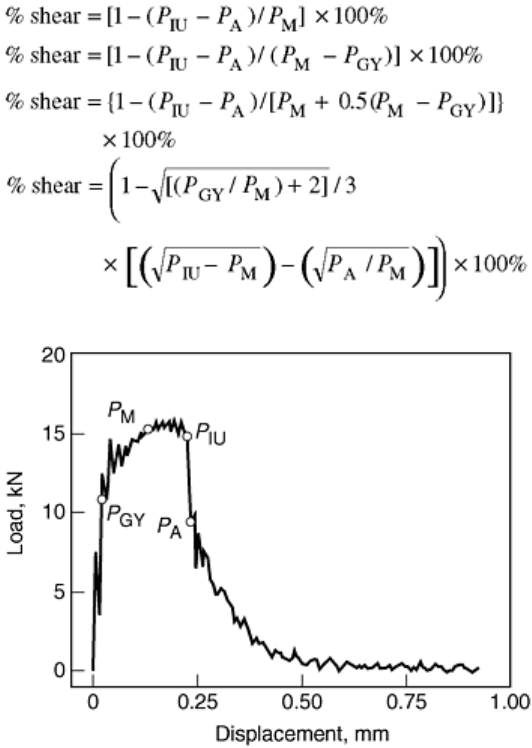
irradiation embrittlement of nuclear pressure vessel steels (Ref 30). Several instrumented impact tests have also
been developed for plastics (Ref 31) with the ISO standard 179-2 on instrumented Charpy testing of plastics
(Ref 32). The following discussions focus on requirements for steels, while more information on impact testing
of plastics and ceramics are addressed in the article“Mechanical Testing of Polymers and Ceramics” in this
Volume. For nonmetallic materials, such as plastics and ceramics, the application of available models involving
energy considerations may be necessary for arriving at the true toughness values (Ref 24).
Standard Methods. Extensive efforts in the development of instrumented Charpy tests began in the 1960s and
1970s with the advent of fracture mechanics and precracked Charpy V-notch specimens, when a series of
seminars and conferences in the 1970s (Ref 33, 34, 35, and 36) examined the role of instrumented impact
testing in the evaluation of dynamic fracture toughness (Ref 24). The International Institute of Welding first
attempted to standardize the instrumented Charpy test, but concluded that the test was not sufficiently
documented, and the effort was discontinued (Ref 37). A few years later, two significant events prompted
serious consideration of standardization. The development of the K
IR
curve by the Pressure Vessel Research
Committee and its inclusion in the ASME Code, Section III, created the need for dynamic initiation toughness,
K
Id
, data. Simultaneously, two other related groups began formulating procedures and conducting
interlaboratory round robins. The Pressure Vessel Research Committee/Metals Property Council Task Group on
Fracture Toughness Properties for Nuclear Components developed procedures for measuring K
Id
values from
precracked Charpy specimens (Ref 38).
The Electric Power Research Institute (EPRI) funded work to develop procedures known as the “EPRI
Procedures” (Ref 28, 39). This procedure is summarized in the following section, “General Test Requirements.”
Since that time, important theoretical and technical developments have occurred, as outlined in Ref 24. Efforts
have also been made in the development of standards. In 1992, the European Structural Integrity Society (ESIS)
formed a working party (formed within ESIS Technical Subcommittee 5) devoted to instrumented impact
testing on subsize Charpy-V specimens of metallic materials. In 1994, ESIS issued a draft of a standard method
for the instrumented Charpy V-notch test on metallic materials (Ref 40). This method allows one to estimate an
approximate value of the proportion of ductile fracture surface by one of the following formulas:
where P
GY
, P
M
, P
IU
, and P
A
are characteristic points on the load-time diagram shown in Fig. 12.

Fig. 12 Load vs. time record showing the definitions of the various load points used in various models to
estimate the percent shear fracture; P
GY
, characteristic value for onset of plastic deformation; P
M
,
maximum load; P
IU
, load at the initiation of unstable crack propagation; P
A
, load at the end of unstable
crack propagation.
The working group also performed round-robin testing to help develop the state of knowledge on the dynamic
behavior of miniaturized impact specimens (Ref 41). In 1992, a formal committee also was formed for
development of a possible JIS standard for evaluation of dynamic fracture toughness by the instrumented
Charpy impact testing method. Problems to be resolved before the standardization of the instrumented Charpy
impact test method are pointed out in Ref 42.
General Test Requirements. Only subtle differences exist between the “EPRI Procedures” (Ref 28) and the
Pressure Vessel Research Committee procedures for measuring K
Id
values from precracked Charpy specimens
(Ref 38, 43). The following test requirements are taken from the EPRI procedures.
The load signal obtained from an instrumented striker during an impact test oscillates about the actual load
required to deform the specimen. Therefore, the signal analysis procedure employed should minimize the
deviation of the apparent load from the actual specimen deformation load. A simplistic view of the impact event
allows three major areas for test specification to be identified: initial loading, limited frequency response, and
electronic curve fitting.
The impact loading of a specimen will create inertial oscillations in the contact load between striker and
specimen, and a time interval between 2τ and 3τ is required for the load to be dissipated, where τ is related to
the period of the apparent specimen oscillations and can be predicted empirically for a span-to-width ratio of 4
by:
(Eq 4)
where W is the specimen width, B is the specimen thickness, C
s
is the specimen compliance, E is the Young's
modulus, S
o
is the speed of sound in the specimen, and τ is typically 30 μs for standard Charpy steel specimens.
When any time, t, is less than 2τ, it is not possible to use the striker signal to measure the portion of the
specimen load caused by inertial effects. An empirical specification for reliable load and time evaluation is:
t ≥ 3τ
(Eq 5)
Control of t is obtained by control of the initial impact velocity. The constant 3 in Eq 5 may be as low as 2.3
without adversely affecting the test results, if the curve-fitting technique described below is followed. A value
of 3 was chosen for the case of “unlimited” frequency response. The original EPRI procedures corresponded to
the 2.3 factor and included the selective filtering for curve fitting (Ref 28). Computer simulations of the Charpy
test have approximately verified the value of τ and the 3τ criterion (Ref 44).
The potential problem of limited frequency response of the transducer amplifier is avoided by specifying:
t ≥ 1.1t
R
(Eq 6)
where t
R
is defined as the 0.915 dB response time of the instrumentation, as indicated in Eq 3. Inadequate
response results in a distorted signal response. It is important to note that the electronic attenuation must be
representative of a resistance-capacitance circuit for Eq 6 to apply.
The curve fitting of the oscillations is achieved by specifying a minimum t
R
. The amplitude of the observed
oscillations is therefore reduced such that the disparity between tup contact load and effective deformation load
is minimal. For the best test, it has been empirically found for resistance-capacitance circuit systems that:
t
R
≥ 1.4t
(Eq 7)
is adequate for the electronic curve fitting without altering the overall curve, when t ≥ 2.3τ. When t ≥ 3τ, it is
not necessary to electronically curve fit because the disparity between the contact load and the specimen
deformation load is less than approximately 5%.
The requirements for obtaining acceptable load-time records (in particular, Eq 5) result in the need to control
V
o
. By controlling the impact velocity, a corresponding control of kinetic energy (E
o
) is inherent. The reduction
in striker velocity during the impact loading of the specimen should therefore be minimized. A conservative
requirement is:
E
o
≥ 3W
M
(Eq 8)

where W
M
is the system energy dissipated to maximum load P
M
. This requirement ensures that the tup velocity
is not reduced by more than 20% up to maximum load. This requirement is seldom a problem for full-impact
Charpy V-notch tests; Eq 8 may not be met, however, when precracked Charpy tests are conducted for very
tough materials. The test requirements for reliable load measurement are summarized as follows:
Inertial effects t ≥ 3τ
Limited frequency response
t ≥ 1.1t
R
, required only if 2.3τ ≤ t <3τ
Electronic curve fitting t
R
≥ 1.4τ
Energy criterion E
o
≥ 3W
M
The time t corresponds to the shortest time required for measurement after the specimen has been impacted;
that is, t is the time to maximum load t
M
for the elastic fracture, and t is the time to general yield, t
GY
, in the
postgeneral yield fracture (See Fig. 11). The specification for electronic curve fitting is only required if 2.3τ ≤ t
< 3τ. Because it is often difficult to ensure that t ≥ 3τ and because the filtering has no adverse effect when t ≥
2.3τ filtering at t
R
≥ 1.4τ is always possible, assuming that t ≥ 1.1t
R
.
Limitations on Testing. Violation of any of the general test requirements presented above will invalidate the
data obtained from instrumented Charpy V-notch tests. Limitations of this testing technique are the same as
those for standard Charpy testing. The effects of small size relative to typical component size, the rounded
machine notch, and shallow notch depth restrict general applicability and usefulness of the Charpy test. Note
that the notch depth for the Charpy V-notch specimen is too shallow to prevent yielding across the gross section
of the specimen.
Instrumentation has allowed separation of energy components and measurement of applied loads throughout the
fracture event, but direct determination of the initiation component is not directly possible for ductile
(microvoid coalescence) initiation from the instrumented test record. Some of these limitations have been
addressed by fatigue precracking the Charpy specimen, which eliminates the notch effects and makes it a small
fracture-mechanics-type specimen.
References cited in this section
23. W. Schmitt, W. Böhme, and D.-Z. Sun, New Developments in Fracture Toughness Evaluation,
Structural Integrity: Experiments, Models, Applications—European Conference of Fracture (ECF) 10,
Vol 1, Engineering Materials Advisory Service, 1990, p 159–170
24. P.R. Sreenivasan, Instrumented Impact Testing—Accuracy, Reliability, and Predictability of Data,
Trans. Indian Inst. Met., Vol 49 (No. 5), Oct 1996, p 677–696
25. B. Augland, Fracture Toughness and the Charpy V-Notch Test, Br. Weld. J., Vol 9 (No. 7), 1962, p 434
26. G.D. Fearnehough and C.J. Hoy, Mechanism of Deformation and Fracture in the Charpy Test as
Revealed by Dynamic Recording of Impact Loads, J. Iron Steel Inst. Jpn., Vol 202, 1964, p 912
27. R.A. Wullaert, Application of the Instrumented Charpy Impact Test, Impact Testing of Metals, STP 466,
ASTM, 1970, p 148–164
28. D.R. Ireland, W.L. Server, and R.A. Wullaert, “Procedures for Testing and Data Analysis,” ETI Report
TR-75-43, Effects Technology, Inc., Santa Barbara, CA, Oct 1975
29. D.R. Ireland, Procedures and Problems Associated with Reliable Control of the Instrumented Impact
Test, Instrumented Impact Testing, STP 563, ASTM, 1974, p 3–29
30. L.E. Steele, Ed., Radiation Embrittlement of Nuclear Pressure Vessel Steels: An International Review,
STP 1011, ASTM, 1989
31. S. Kessler, G.C. Adams, S.B. Driscoll, and D.R. Ireland, Instrumented Impact Testing of Plastics and
Composites Materials, STP 936, ASTM, 1986

32. “Plastic—Determination Of Charpy Impact Properties: Part 2—Instrumented Impact Test,” ISO-179-2,
International Organization for Standardization
33. Impact Testing of Metals, STP 466, ASTM, 1970
34. Instrumented Impact Testing, STP 563, ASTM, 1974
35. C.E. Turner, in Advanced Seminar on Fracture Mechanics, EURA-TOM-ISPRA Courses, 1975
36. Dynamic Fracture Toughness, The Welding Institute and The American Society for Metals, 1976
37. E.C.J. Buys and A. Cowan, Interpretation of the Instrumented Impact Test, Weld. World, Vol 8 (No. 1),
1970, p 70–76
38. Pressure Vessel Research Committee/Metal Properties Council Working Group on Instrumented
Precracked Charpy Testing, “Instrumented Precracked Charpy Testing: Report I—Recommended
Testing Procedure, Report II—Associated Test Program,” Westinghouse Research Laboratory,
Pittsburgh, PA, 1974
39. R.A. Wullaert, Ed., CSNI Specialist Meeting on Instrumented Precracked Charpy Testing, Nov 1980,
EPRI NP-2102-LD, Electric Power Research Institute, 1981
40. “ESIS Instrumented Charpy V-Notch Standard,” Proposed Standard Method for the Instrumented
Charpy-V Impact Tests on Metallic Materials, Draft 10, ESIS, Jan 14, 1994
41. E. Lucon, Instrumented Impact Testing of Sub-Size Charpy-V Specimens: The Activity of the ESIS
TC5 Working Party, ECF 11—Mechanisms and Mechanics of Damage and Failure, Vol 1, Elsevier,
1996, p 621
42. T. Kobayashi and I. Yamamoto, Progress and Development in the Instrumented Charpy Impact Testing
Method, Bull. Jpn. Inst. Met., Vol 32 (No. 3), 1993, p 151–159 (in Japanese)
43. W.L. Server, Impact Three-Point Bend Testing for Notches and Precracked Specimens, J. Test. Eval.,
Vol 6 (No. 1), 1978, p 29–34
44. D.M. Norris, D. Quiñones, and B. Moran, Computer Simulation of Plastic Deformation in the Charpy
V-Notch Impact Test, What Does the Charpy Test Really Tell Us?: Proceedings of the American
Institute of Mining, Metallurgical and Petroleum Engineers, American Society for Metals, 1978, p 22–
32
Impact Toughness Testing
Precracked Charpy Test
By inducing a fatigue precrack in the Charpy specimen, the notch acuity and depth restrictions are eliminated.
Early work concentrated on correlations with fracture toughness using only the total absorbed energy (i.e.,
uninstrumented testing). These energy values usually are normalized per unit area (A) below the fatigue crack;
the normalized energy values are designated as W/A.
Most of the correlations of W/A with fracture toughness have been conducted using slow-bend specimens. The
basic problem in reaching an impact correlation is the difference in loading rates between the Charpy impact
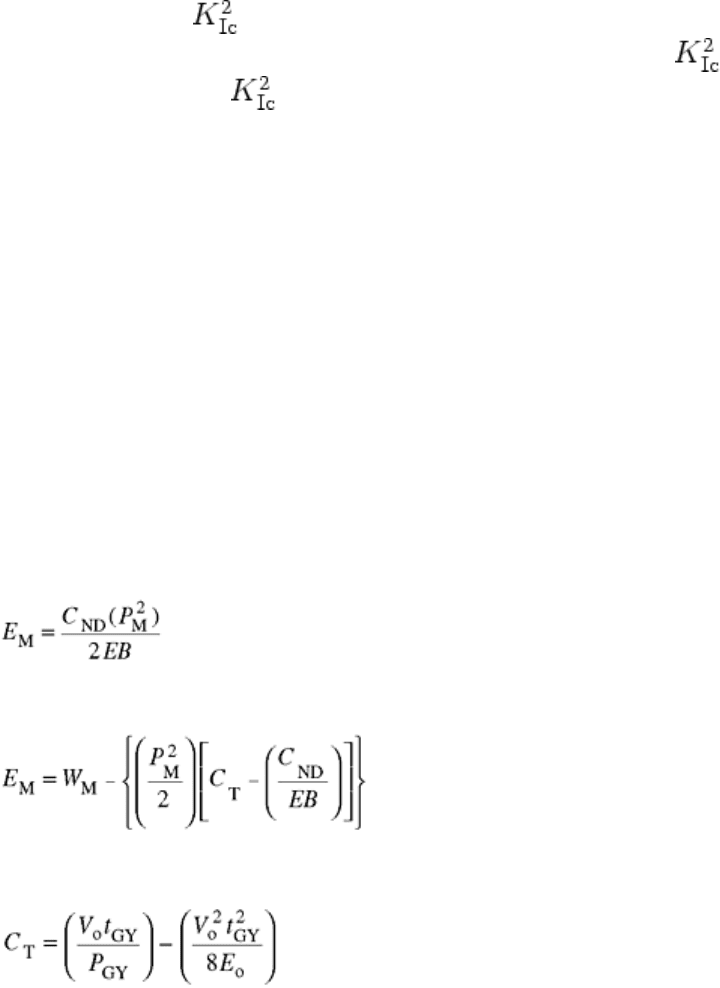
and the static K
Ic
tests, particularly for loading-rate sensitive materials (Ref 45). A general trend exists for a
correlation between /E and W/A, but the limited data and scatter make this difficult to utilize (Ref 16). A
better correlation with K
Id
may be possible. The reason for using /E as the basis is the approximate
proportionality between /E and W/A, based on a presumed fracture mechanics relationship (Ref 45).
The precracked Charpy W/A values can also be used to estimate the nil-ductility transition temperature. The
typical technique defines an inflation point between lower shelf and transition region behavior as the estimated
nil-ductility transition temperature (Ref 46). Some exceptions have been noted to this approach (Ref 47).
Instrumented Data
The types of data and test techniques used for instrumented precracked Charpy testing are the same as those
discussed earlier for instrumented Charpy impact testing. The 3τ criterion, which limits the impact velocity,
becomes more important for deeply cracked, brittle materials. The greatest advantage of precracking is the
transformation of the Charpy V-notch specimen into a dynamic fracture mechanics test piece. The direct
calculation of fracture toughness (within certain limitations) is now possible using the instrumented load-time
information. The following discussion presents the calculational aspects of these fracture toughness parameters.
If fracture is known to initiate at maximum load (as it usually does for cleavage initiation), the energy value of
W
M
(see Fig. 11) can be considered an initiation energy. However, W
M
includes contributions other than that
caused by the deflection of the specimen. Therefore, a compliance energy correction is needed to determine the
true specimen energy, E
M
(Ref 48). When the fracture is linear elastic (fracture before general yield; see the
first two load-time records in Fig. 11), the value of E
M
can be calculated directly:
(Eq 9)
where C
ND
is the nondimensional specimen compliance (Ref 49). For a fracture occurring after general yield
(see Fig. 11), E
M
is obtained by correcting W
M
:
(Eq 10)
where C
T
is the total system compliance calculated at general yield and corrected for the decrease in velocity
through general yield:
(Eq 11)
This compliance correction is assumed to be linear with load, but the actual correction is not so simple.
However, the error in assuming a linear relationship results in a slightly smaller (conversvative) value of E
M
(Ref 43).
It is often desirable to partition the total fracture energy into initiation and postinitiation (propagation)
components. Assuming initiation occurs at maximum load, the propagation energy, E
P
, is:
E
P
= E
T
- E
M
(Eq 12)
where E
T
is the total fracture energy, as determined from a dial indicator, kinetic energy change (initial and
final velocity measurements), or ΔE
o
.
Linear Elastic Fracture Toughness. When the fracture is elastic (fracture occurs before general yield), the stress-
intensity factor, K
Ic
, can be calculated by applying linear elastic fracture mechanics:
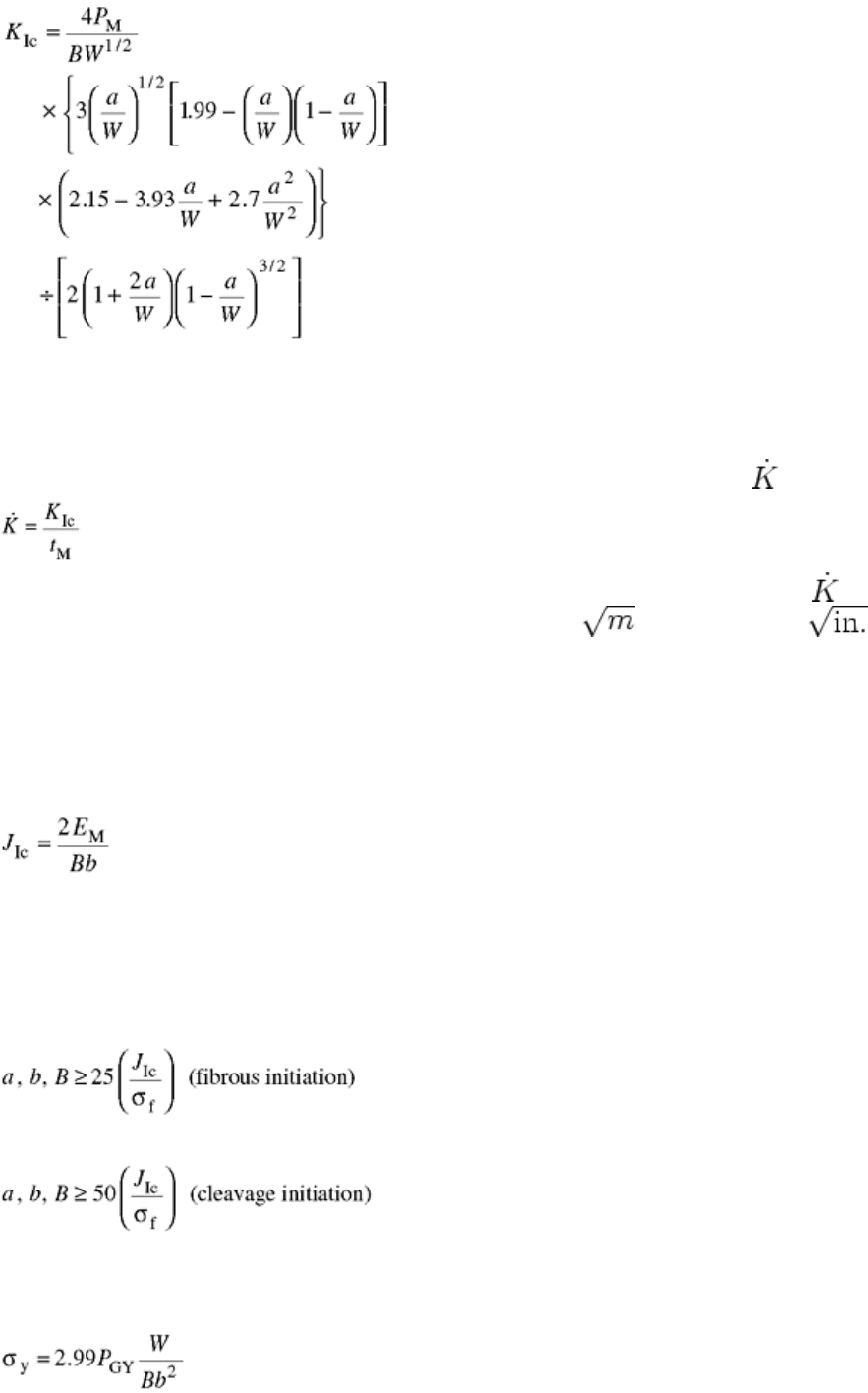
(Eq 13)
where a is the crack length.
The ASTM size requirements for a valid K
Ic
are quite limiting, even if a dynamic yield strength is used.
However, the general specimen size requirements of ASTM E 399 may be too conservative for dynamic testing
of ferritic medium-strength steels (Ref 50). Therefore, if general yielding has not occurred, a linear-elastic value
of fracture toughness, K
Ic
, generally is calculated. The stress intensification rate is calculated as:
(Eq 14)
This loading rate reflects the dynamic aspect of the loading, because the lowest for impact loading of
precracked Charpy specimens is on the order of 11 × 10
4
MPa · s
-1
× (1 × 10
5
ksi · s
-1
).
Postgeneral Yield Fracture Toughness. When general yielding occurs, an energy-based value of the J-integral
can be used to obtain a measure of fracture toughness. The calculation of ductile fracture toughness, J
Ic
, is
contingent upon knowing the initiation point of fracture on the load-time record. For cleavage-initiated fracture,
this point generally corresponds to maximum load. However, for fibrous (ductile) initiation, maximum load is
generally a nonconservative assumption. When the initiation point is known or has been determined
experimentally (Ref 51) and when a/W ≥ 0.5 (Ref 52), then:
(Eq 15)
where b is the remaining ligament depth (W - a). A stress-intensity factor K
Jc
can be obtained from the J
Ic
value
as:
K
Jc
= (EJ
Ic
) 1/2
(Eq 16)
An average K can also be computed, as in Eq 16, by using a K
Jc
value. Validity criteria related to specimen
dimensions appear to be (Ref 43):
(Eq 17)
and
(Eq 18)
where σ
f
is the flow stress, defined as the average of the yield stress and the ultimate stress. For dynamic
loading, the yield stress, σ
y
, and flow stress, σ
f
, of standard Charpy V-notch specimens can be estimated for
postgeneral yield behavior as:
(Eq 19)
and

(Eq 20)
The general form of the equation results from slip-line field solutions for blunt-notch specimens, and the
constant 2.99 has been obtained from extrapolation of results from a slip-line field solution that included the tup
indentation at the center loading point (Ref 53). The constant of 2.99 reduces to 2.85 for sharp-notch specimens
with a fatigue precrack. The stress values obtained using this approach agree favorably with high rate tensile
test results (Ref 54).
Limitations. The test requirements and data analysis procedures described in this article were developed for
ferritic pressure vessel steels. A review of instrumented precracked Charpy testing can be found in Ref 55,
which discusses the theory and applicability of instrumented precracked Charpy testing. Not all of the
relationships and approaches presented in Ref 55 are universally accepted because standards or recommended
practices do not currently exist.
Related Test Techniques
Several attempts have been made to use the precracked Charpy specimen at loading rates beyond the limits
applicable to quasi-static analysis. The procedures described above assume a quasi-static situation for times
greater than the limiting values near 3τ. One such attempt for larger than Charpy-size specimens is described in
Ref 56, in which strain gages were mounted near the crack tip to avoid many of the spurious wave effects.
Other studies have been conducted using Hopkinson bar techniques (Ref 57) and the shadow optic method of
caustics (Ref 58). These studies indicate the need for dynamic analysis when using the instrumented Charpy
striker approach at high loading rates.
References cited in this section
16. “Rapid Inexpensive Tests for Determining Fracture Toughness,” National Materials Advisory Board,
National Academy of Sciences, Washington, D.C., 1976
43. W.L. Server, Impact Three-Point Bend Testing for Notches and Precracked Specimens, J. Test. Eval.,
Vol 6 (No. 1), 1978, p 29–34
45. T.M.F. Ronald, J.A. Hall, and C.M. Pierce, Usefulness of Precracked Charpy Specimens for Fracture
Toughness Screening Tests of Titanium Alloys, Metall. Trans., Vol 3, April 1972, p 813–818
46. G.M. Orner and C.E. Hartbower, Transition-Temperature Correlations in Construction Alloy Steels,
Weld. J., Vol 40 (No. 9), Oct 1961, p 459s
47. J.H. Gross, The Effect of Strength and Thickness on Notch Ductility, Weld. J., Vol 48 (No. 10), Oct
1969, p 441s
48. W.L. Server, D.R. Ireland, and R.A. Wullaert, “Strength and Toughness Evaluations from an
Instrumented Impact Test,” ETI TR-74-29R, Effects Technology, Inc., Santa Barbara, CA, Nov 1974
49. H.J. Saxton et al., Load Point Compliance of the Charpy Impact Specimen, Instrumented Impact
Testing, STP 563, ASTM, 1974, p 30–49
50. W.L. Server, R.A. Wullaert, and J.W. Sheckherd, “Verification of the EPRI Dynamic Fracture
Toughness Testing Procedures,” ETI TR 75–42, Effects Technology, Inc. Santa Barbara, CA, Oct 1975
51. W.L. Server, W. Oldfield, and R.A. Wullaert, “Experimental and Statistical Requirements for
Developing a Well-Defined KIR Curve,” EPRI NP-372, Electric Power Research Institute, Palo Alto,
CA, May 1977
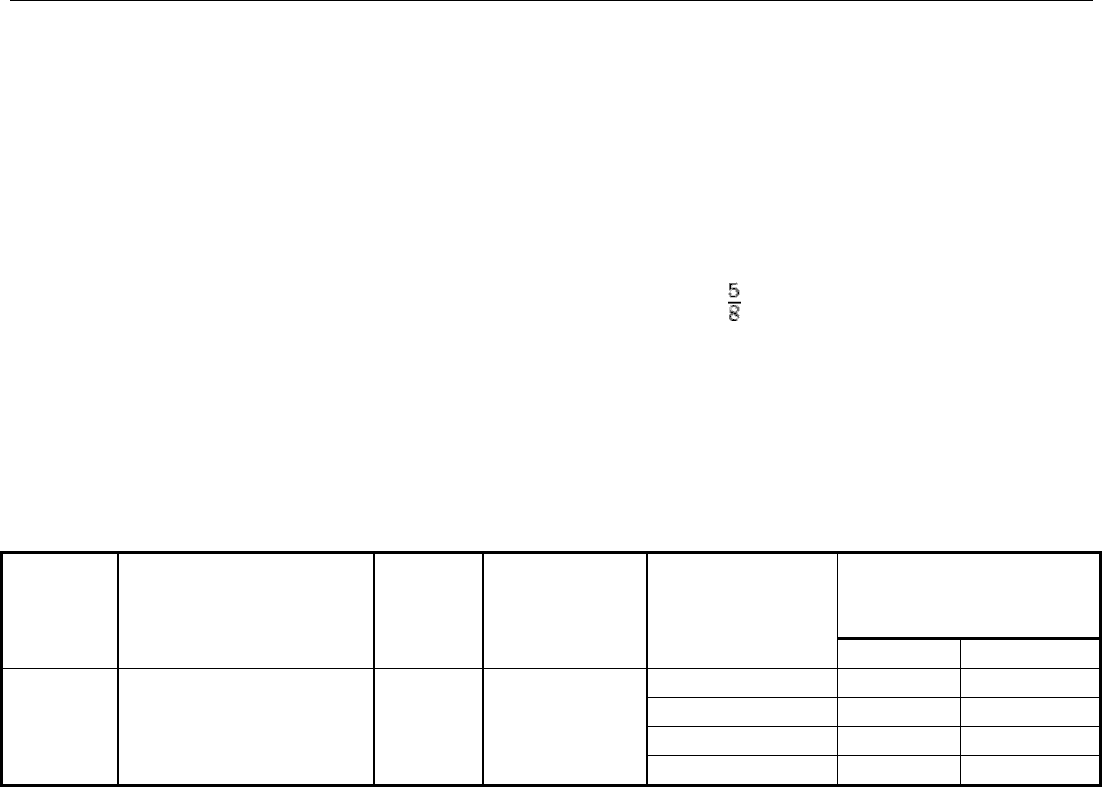
52. J.D.G. Sumpter and C.E. Turner, Method for Laboratory Determination of J
c
, Cracks and Fracture, STP
601, ASTM, 1976, p 3–18
53. D.J.F. Ewing, Calculations on the Bending of Rigid/Plastic Notched Bars, J. Mech. Phys. Solids, Vol
16, 1968, p 205–213
54. W.L. Server, General Yielding of Charpy V-Notch and Precracked Charpy Specimens, J. Eng. Mater.
Technol. (Trans. ASME), Vol 100, April 1978, p 183–188
55. Committee on Safety of Nuclear Installations Specialist Meeting on Instrumented Precracked Charpy
Testing, EPRI NP-2102-LD, Electric Power Research Institute, Palo Alto, CA, Nov 1981
56. F.J. Loss, Ed., “Structural Integrity of Water Reactor Pressure Boundary Components,” Progress Report
Ending Feb 1976, NRL Report 8006, Naval Research Laboratory, Washington, D.C., Aug 1976
57. T. Nicholas, “Instrumented Impact Testing Using a Hopkinson Bar Apparatus,” AFML-TR-75-54, Air
Force Materials Laboratory, Wright-Patterson Air Force Base, Dayton, OH, July 1975
58. J.F. Kalthoff et al., “Measurements of Dynamic Stress Intensity Factors in Impacted Bend Specimens,”
Committee on Safety of Nuclear Installations Specialist Meeting on Instrumented Precracked Charpy
Testing, EPRI NP-2102-LD, Electric Power Research Institute, Palo Alto, CA, Nov 1981
Impact Toughness Testing
Drop Weight Testing
Because Charpy V-notch testing does not necessarily reveal the same transition temperature as that observed
for full-size parts, many other tests have been devised. Two such tests have achieved some degree of popularity.
These are the drop-weight test (DWT) and the drop-weight tear test (DWTT). Both of these tests were
developed at the United States Naval Research Laboratory. Both tests yield a transition temperature that more
nearly coincides with that of full-size parts. This has been described as the nil-ductility temperature (NDT).
Both tests have limited usage because of the required specimen sizes. There are three types of DWT specimens,
as shown in Table 4. The smallest of these measures 16 × 51 × 127 mm ( × 2 × 5 in.), and thus, when four to
eight specimens are required, a considerable amount of material is expended. Often parts are not of sufficient
size or are not shaped in such a manner to allow preparation of such specimens. A provision is made for
remelting and casting material to specimen size. Most DWT tests are made on plate that is 9.5 mm (⅜ in.) thick
or thicker. The DWTT is also a plate testing specification. This test requires a specimen 76 × 305 mm (3 × 12
in.) by full plate size.
Table 4 Standard drop-weight test (DWT) conditions
Drop-weight energy
for given yield strength
level
(a)
Type of
specimen
Specimen size, mm
(in.)
Span,
mm
(in.)
Deflection
stop,
mm (in.)
Yield strength
level,
MPa (ksi)
J
ft · lbf
210–340 (30–50) 800
600
340–480 (50–70) 1100
800
480–620 (70–90) 1350
1000
P-1 25.4 × 89 × 356 (1 ×
3½ × 14)
305
(12.0)
7.6 (0.3)
620–760 (90–1650
1200
